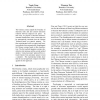33 search results - page 2 / 7 » Learning to Disambiguate Relative Pronouns |
ACL
2012
11 years 8 months ago
2012
The Chinese comma signals the boundary of discourse units and also anchors discourse relations between adjacent text spans. In this work, we propose a discourse structureoriented ...
ACL
2006
13 years 7 months ago
2006
This paper presents an unsupervised learning approach to disambiguate various relations between name entities by use of various lexical and syntactic features from the contexts. I...
IJCNLP
2005
Springer
13 years 11 months ago
2005
Springer
Japanese relative clause constructions (RCC’s) are defined as being the NP’s of structure ‘S NP’, noting the lack of a relative pronoun or any other explicit form of noun-...
CIARP
2004
Springer
13 years 11 months ago
2004
Springer
We present a method for extracting selectional preferences of verbs from unannotated text. These selectional preferences are linked to an ontology (e.g. the hypernym relations foun...
CAISE
2004
Springer
13 years 11 months ago
2004
Springer
The so-called Semantic Web vision will certainly benefit from automatic semantic annotation of words in documents. We present a method, called structural semantic interconnections ...

